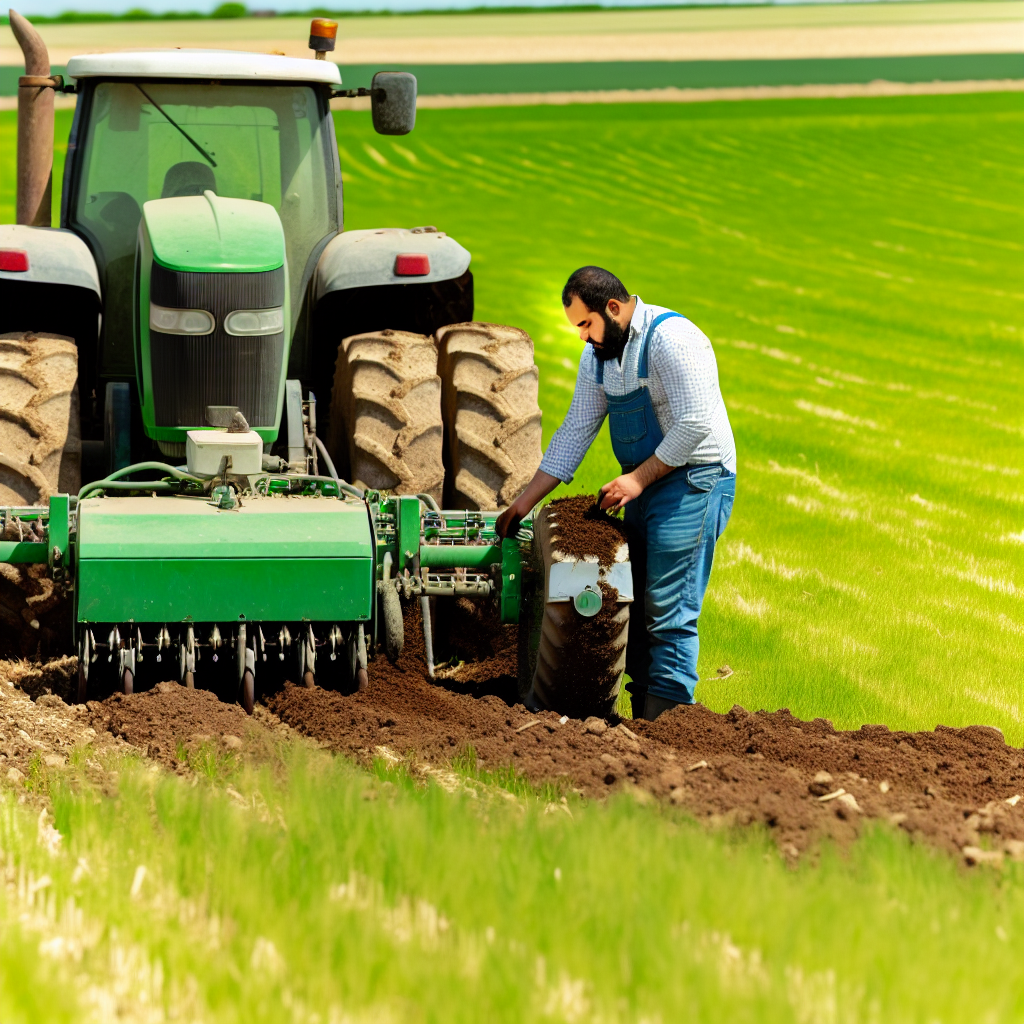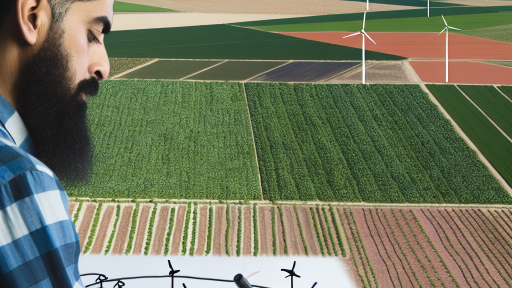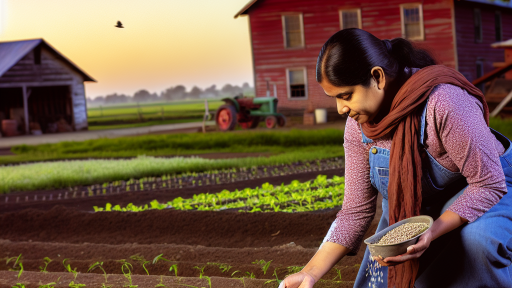Introduction to Conservation Tillage
Definition and Importance
Conservation tillage refers to farming practices that minimize soil disturbance.
This method retains soil structure and moisture for better crop yields.
Farmers adopt conservation tillage to improve soil health and reduce erosion.
This approach limits the frequency and intensity of soil disturbance.
Benefits of Conservation Tillage
One significant benefit is enhanced moisture retention in the soil.
This practice reduces water runoff, keeping moisture available for plants.
Moreover, it helps maintain organic matter in the soil.
This organic matter supports soil microbes that improve soil fertility.
Consequently, crops grown in well-managed soils yield better harvests.
Environmental Impacts
Conservation tillage also has positive environmental impacts.
By reducing soil erosion, it protects waterways from sedimentation.
This method promotes biodiversity by providing habitats for various organisms.
Hence, it aids in climate change mitigation by sequestering carbon in the soil.
Economic Aspects
Implementing conservation tillage can lead to cost savings for farmers.
It reduces the need for fuel and equipment maintenance.
Transform Your Agribusiness
Unlock your farm's potential with expert advice tailored to your needs. Get actionable steps that drive real results.
Get StartedFarmers can also benefit from higher quality and quantity of crops.
As a result, the economic advantages can be substantial over time.
Types of Conservation Tillage Practices
No-till Practices
No-till practices leave the soil undisturbed.
This method preserves soil structure and moisture content.
Farmers plant crops directly into the residue from the previous harvest.
As a result, organic matter remains on the soil surface.
This approach reduces erosion and enhances water retention.
Additionally, it minimizes fuel use and labor costs.
Reduced-till Practices
Reduced-till practices involve limited soil disturbance.
Farmers use implements to disturb only a portion of the soil.
This method helps maintain more plant residues than traditional tillage.
It balances soil aeration with moisture preservation.
Furthermore, it can improve soil fertility over time.
Farmers often find this method economically beneficial.
Strip-till Practices
Strip-till practices involve tilling narrow strips of soil.
Farmers prepare specific rows for planting while leaving the rest intact.
This reduces soil erosion and enhances moisture conservation.
Additionally, it allows for effective planting of cover crops.
The practice promotes healthier soil biology and organic matter content.
Moreover, it supports effective weed management strategies.
Benefits of Conservation Tillage for Soil Moisture Retention
Improved Soil Structure
Conservation tillage enhances soil structure significantly.
This practice allows the soil to maintain better aeration.
Moreover, it improves water infiltration rates.
As a result, crops receive essential moisture more efficiently.
Showcase Your Farming Business
Publish your professional farming services profile on our blog for a one-time fee of $200 and reach a dedicated audience of farmers and agribusiness owners.
Publish Your ProfileReduction in Soil Erosion
By minimizing disturbance, conservation tillage prevents erosion.
This method keeps soil particles intact and protects moisture.
Consequently, less runoff occurs during rainfall events.
This is crucial for retaining soil moisture for crops.
Enhanced Organic Matter Content
Conservation tillage increases the organic matter content in the soil.
This organic material acts as a sponge, capturing moisture.
Furthermore, it promotes beneficial microbial activity within the soil.
This activity improves soil’s overall fertility and moisture retention.
Lower Evaporation Rates
This practice helps lower evaporation rates from the soil surface.
The protective cover of residues reduces direct sun exposure.
Therefore, soils remain moist for longer periods.
This is especially beneficial during hot, dry seasons.
Support for Crop Yields
Ultimately, conservation tillage supports better crop yields.
By conserving moisture, plants access the water they need to grow.
Healthy crops are better equipped to withstand drought conditions.
Thus, farmers enjoy reliable harvests even in challenging climates.
Uncover the Details: Integrating Carbon Sequestration into Farming Systems
Impact of Conservation Tillage on Soil Structure and Health
Improving Soil Structure
Conservation tillage enhances the physical structure of the soil.
This practice reduces soil compaction significantly.
As a result, air and water can circulate more freely.
Healthy soil structure promotes root development.
Roots grow deeper and uptake nutrients more effectively.
In turn, this leads to improved crop yields.
Enhancing Soil Health
Conservation tillage is beneficial for soil health.
It increases organic matter content in the soil.
This organic matter supports a diverse range of microorganisms.
Microorganisms play a vital role in nutrient cycling.
Moreover, they help break down organic residues.
Consequently, healthier soils can better resist pests and diseases.
Reducing Erosion and Moisture Loss
Implementing conservation tillage reduces soil erosion.
Less erosion means more soil remains in place.
In addition, it helps preserve valuable topsoil.
This practice retains soil moisture effectively.
As a result, crops have better access to water during dry spells.
Consequently, farmers can reduce irrigation needs.
Encouraging Biodiversity
Conservation tillage promotes biodiversity in soil ecosystems.
Diverse plant and animal life contribute to a balanced environment.
This helps increase the resilience of agricultural systems.
Healthy biodiversity also improves pollination rates.
Moreover, varied root systems enhance nutrient uptake.
Showcase Your Farming Business
Publish your professional farming services profile on our blog for a one-time fee of $200 and reach a dedicated audience of farmers and agribusiness owners.
Publish Your ProfileOverall, conservation tillage supports a vibrant soil community.
See Related Content: Wildlife-Friendly Practices for Sustainable Farms
Best Practices for Implementing Conservation Tillage in Different Crop Systems
Understanding Conservation Tillage
Conservation tillage reduces soil disturbance significantly.
This practice helps retain soil moisture effectively.
Farmers can implement it across various crop systems.
Crop-Specific Strategies
Cereal Crops
Cereal crops benefit greatly from conservation tillage.
Use no-till farming methods to minimize soil disruption.
Consider cover crops to enhance soil structure.
They help prevent erosion while improving moisture retention.
Legume Crops
Legume crops thrive in conservation tillage systems.
Plant legumes in rotation with cereal crops.
This practice improves nitrogen levels in the soil.
Additionally, it enhances overall soil health.
Root Crops
Root crops require careful tillage management.
Use reduced tillage techniques to protect root structures.
Maintaining residue from previous crops improves moisture retention.
Benefits of Cover Crops
Cover crops play a vital role in conservation tillage.
They shield the soil from erosion and nutrient loss.
Additionally, they promote beneficial microorganisms in the soil.
This leads to improved soil fertility and moisture retention.
Monitoring Soil Health
Regularly assess soil health to ensure success.
Soil testing provides crucial information about nutrient levels.
Keep track of moisture levels to inform irrigation practices.
Adapting practices based on soil health is essential.
Community Involvement and Education
Engagement with local farming communities enhances knowledge sharing.
Participate in workshops to learn about conservation practices.
Collaboration promotes more sustainable farming techniques.
Explore Further: Natural Recycling Methods for Agricultural Waste

Challenges and Limitations of Conservation Tillage in Arid Regions
Soil Degradation Risks
Soil degradation poses a significant challenge in arid regions.
The lack of organic matter reduces soil structure and health.
Consequently, erosion becomes more prevalent over time.
Furthermore, compaction may inhibit root growth and crop yields.
Water Availability Issues
Water scarcity remains a critical limitation in arid landscapes.
Despite conservation tillage’s benefits, it does not solve water shortages.
In some cases, moisture retention may be inadequate for crops.
Therefore, farmers must carefully plan irrigation strategies.
Weed Management Challenges
Weed control can become more complicated under conservation tillage.
Without proper management, weeds can outcompete crops for resources.
Additionally, some methods may encourage certain weed species to thrive.
Effective herbicide application plays a crucial role in managing this issue.
Showcase Your Farming Business
Publish your professional farming services profile on our blog for a one-time fee of $200 and reach a dedicated audience of farmers and agribusiness owners.
Publish Your ProfileEconomic Considerations
The initial investment in conservation tillage equipment can be high.
Farmers may face financial challenges when adopting new practices.
Moreover, economic returns could take time to become apparent.
This delay can discourage adoption in less affluent communities.
Knowledge and Training Gaps
There is often a lack of knowledge about conservation tillage practices.
Farmers may struggle to adapt to new methods effectively.
Training programs and support are essential for successful implementation.
Resources should be directed towards educating farmers in arid regions.
Uncover the Details: Organic Water Conservation Methods for Farmers
The Role of Cover Crops in Enhancing Conservation Tillage Effectiveness
Introduction to Cover Crops
Cover crops serve as a key element in conservation tillage practices.
They protect soil from erosion and compaction.
Moreover, they enhance soil structure and fertility.
Farmers utilize various types of cover crops for different benefits.
Benefits of Cover Crops
Cover crops promote soil moisture retention effectively.
By providing ground cover, they reduce evaporation.
Additionally, they improve organic matter levels in the soil.
This organic matter increases soil’s water-holding capacity.
Types of Cover Crops
Different cover crops serve various purposes in conservation tillage.
- Legumes like clover fix nitrogen in the soil.
- Grasses, such as rye, suppress weeds effectively.
- Brassicas, like radish, help break up soil compaction.
Choosing the right cover crop depends on the specific goals.
Integrating Cover Crops into a Farming System
Incorporating cover crops requires planning and management.
Farmers should assess the timing for planting and termination.
Proper integration maximizes the benefits of conservation tillage.
Moreover, it enhances the overall sustainability of the farming operation.
Challenges in Using Cover Crops
Some farmers face challenges when adopting cover crops.
These may include increased management complexity.
Additionally, there may be upfront costs associated with planting.
However, the long-term benefits often outweigh these initial drawbacks.
Enhancing Soil Health Through Cover Crops
In summary, cover crops play a vital role in conservation tillage.
They improve soil moisture, fertility, and erosion control.
Thus, increasing the effectiveness of conservation practices.
Case Studies: Successful Conservation Tillage Practices Around the World
Australia’s No-Till Revolution
Australia has seen significant benefits from no-till farming.
This practice has increased soil moisture retention dramatically.
Agricultural leaders like Tom McNair promote these methods nationwide.
Farmers report improved yields due to better water management.
North Dakota’s Crop Rotation Success
In North Dakota, farmers utilize crop rotation alongside conservation tillage.
This strategy improves soil structure and moisture.
Farmers like Sarah Johnson share their success stories at conferences.
They highlight increased resilience during drought conditions.
Brazil’s Integrated Crop-Livestock System
Brazilian farmers integrate livestock with crops.
This system reduces soil compaction and maintains moisture.
Showcase Your Farming Business
Publish your professional farming services profile on our blog for a one-time fee of $200 and reach a dedicated audience of farmers and agribusiness owners.
Publish Your ProfileBy practicing conservation tillage, they enhance soil health.
Farmers such as Renata Alves advocate for this holistic approach.
Benefits in Europe’s Organic Farms
Organic farmers across Europe adopt conservation tillage with enthusiasm.
This approach fosters biodiversity and improves moisture levels.
For example, Michael Schmidt in Germany utilizes cover crops extensively.
His methods lead to healthier soils and increased organic matter.
Innovations in Canada
Canadian researchers focus on precision agriculture in conservation tillage.
This technology optimizes moisture retention in varying soil types.
Farmers like Laura Finch successfully implement these innovations.
Field trials show promising results in moisture conservation.
Additional Resources
Conservation tillage | Sustainable Agriculture Research & Education …
Seeing is Believing: Soil Health Practices and No-Till Farming …




